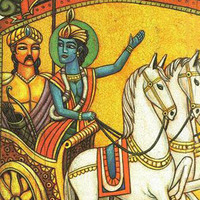 Today, November 28, 2009, millions of Hindus around the world will celebrate Gita Jayanti, the “birthday” of the sacred wisdom text, Bhagavad Gita.
Today, November 28, 2009, millions of Hindus around the world will celebrate Gita Jayanti, the “birthday” of the sacred wisdom text, Bhagavad Gita.
(It is actually the anniversary of the day the Gita is believed to have been spoken – according to the tradition, over five thousand years ago – by Lord Krishna to his friend and devotee Arjuna. In keeping with Hinduism’s idea that all of existence has a personal aspect to it, devotees consider the Gita to be a sort of divine personality, with a birthday of its own.)
The Gita is among the world’s most beloved wisdom texts, both within and outside of the Hindu community. The masters of every major school of Hindu philosophy have written commentaries on the Gita, and in more recent times, some famous readers of the text include Aldous Huxley, Ralph Waldo Emerson, Albert Einstein, and even President Barack Obama (apparently, he read it in college). Gandhi claimed it as his favorite text and a source of inspiration; Robert Oppenheimer quoted from it when the first atom bomb was detonated.
I’m often asked to recommend an edition of the Bhagavad Gita, especially for a non-Indian audience. This can be tricky…
There are hundreds of translations available in the West, and they each
offer a different experience of the same text. For instance, the Gita
that I first fell in love with (and still consider my Gita) is A.C.
Bhaktivedanta Swami Prabhupada’s Bhagavad Gita As It Is. Its strong
emphasis on living the philosophy through the practice of Bhakti (what
the author calls “Krishna consciousness”) has been praised by many
people, and criticized by others.
Still, in the spirit of sharing my own experiences with the Gita, here are five editions that I especially find interesting:
 1. Bhagavad Gita As It Is
1. Bhagavad Gita As It Is
Author: A.C. Bhaktivedanta Swami Prabhupada
Summary:
Reported to be the most widely distributed edition of the Gita, this is
the edition that sparked the worldwide Krishna movement. Prabhupada’s
translation (including elaborate Sanskrit to English transliterations)
transports each verse from ancient India to the contemporary world. His
commentary (“purports”), though sometimes longish, is celebrated as
among the most powerful presentations of the path of devotion to
Krishna – which many understand to be the Gita’s heart and soul – in
the world.
What I Like About It: Its bold and unapologetic in presenting Krishna, calling on the reader to live the Gita, not just read it.
What I Don’t: The strong tone and insistence on a Bhakti interpretation may strike some as preachy or evangelical.
 2. The Bhagavad Gita: Krishna’s counsel in time of war
2. The Bhagavad Gita: Krishna’s counsel in time of war
Author: Barbara Stoller Miller
Summary:
A classic in its own right, Miller’s translation is clean and readable.
In her capable hands, the Gita’s message flows. Another plus: the
paperback is portable and includes an insightful appendix exploring why
Henry David Thoreau took the Gita to Walden pond.
What I Like About It:
It is accessible and non-intimidating to a first-time reader; short and
sweet without missing out on the essentials of the text.
What I Don’t: The
lack of a commentary or textual illumination makes navigating difficult
or ambiguous passages a lonely and sometimes frustrating exercise.
 3. The Bhagavad Gita: A New Translation
3. The Bhagavad Gita: A New Translation
Author: Stephen Mitchell
Summary: Mitchell’s
offering is a relatively recent addition to the cornucopia of Gita
translations and has quickly become a favorite. Emphasizing that the
Gita is, in fact, a song (like all Hindu wisdom texts composed in
metered verses), Mitchell’s rendition attempts to preserve the poetry
and fluidity of Krishna’s timeless message, even while extrapolating
that message to a contemporary context.
What I Like About It: Mitchell
engages with seemingly problematic or contradictory aspects of the
Gita, uplifting interesting questions and forcing readers to delve
within for answers.
What I Don’t: Perhaps in an effort to
appeal to a broad audience, Mitchell’s translation tends towards the
beautiful-but-vague–especially when discussing divinity or theology.
 4. Bhagavad Gita: The Beloved Lord’s Secret Love Song
4. Bhagavad Gita: The Beloved Lord’s Secret Love Song
Author: Graham M. Schweig
Summary:
A wonderful blend between impeccable scholarship and heart-felt
devotion, Schweig’s edition aims to use the art of translating the
Gita’s poetry and precise word choice to uncover its more esoteric
lessons. Schweig paints – both through his poetic translations and in
his textual illumination essays – a portrait of a Krishna who loves his
devotees and yearns to connect with them.
What I Like About It: The
translations capture both accuracy and aesthetics – a rare combination,
indeed – and make the esoteric delightfully understandable.
What I
Don’t: At times the sheer heft of the book and occasionally
overly-academic tone of the essays make an edition that prides itself
on being a love song seem more like a textbook
 5. Paths to God: Living the Bhagavad Gita
5. Paths to God: Living the Bhagavad Gita
Author: Ram Dass (Richard Alpert)
Summary: Technically,
Paths to God is not a translation of the Gita or even a summary study
of the text. Instead, Ram Dass (the acclaimed author of cult classic
Be Here Now) essentially expanded upon the syllabus of a Gita course he
taught in the 1970s. The result is a collection of anecdotes,
reflections, and meditative exercises that approaches the Gita as a
manual for spiritual life.
What I Like About It: Engaging and warm, the book uses the Gita as a springboard to help readers look deeper within.
What I Don’t:
It jumps around at times, pursuing charming but distracting tangents or
veering more towards Ram Dass’s personal musings than what the Gita
actually says.
***
Happy reading!

